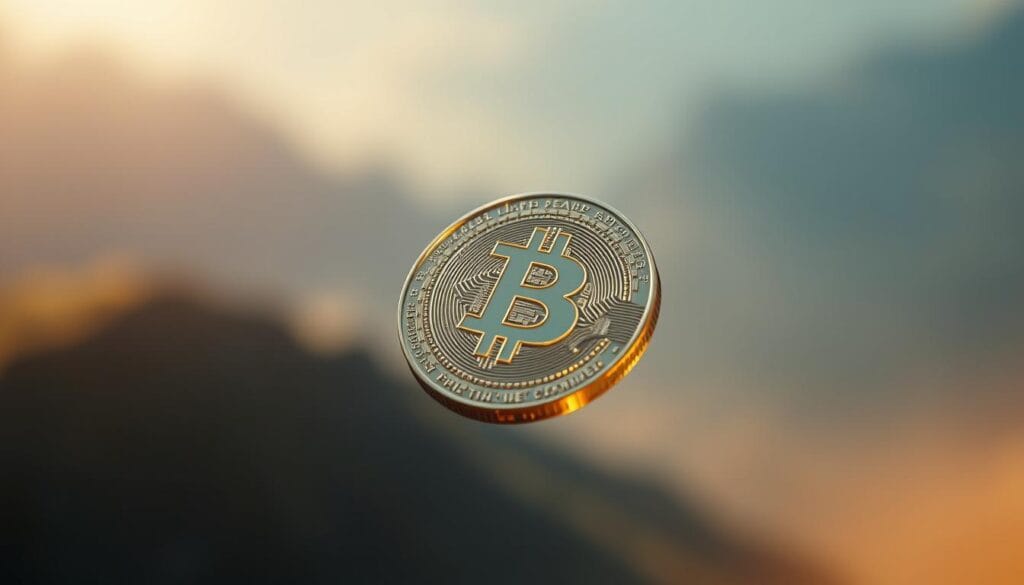By 2025, over $10 trillion in global assets could exist as digital tokens on blockchain networks, according to industry forecasts. This seismic shift isn’t just reshaping Wall Street—it’s redefining how everyday investors interact with markets once reserved for institutions.
Fractional ownership of high-value assets like real estate or precious metals is now possible through blockchain-based digital tokens. Unlike traditional methods, this approach eliminates intermediaries, reduces costs, and enables 24/7 trading. The technology’s transparency ensures every transaction is traceable, addressing long-standing trust issues in physical commodity markets.
Platforms leveraging this innovation allow investors to diversify portfolios with smaller capital commitments. For example, agricultural commodities or commercial properties can be divided into affordable shares. This democratization aligns with growing demand for accessible alternatives to stocks and bonds, particularly among younger, tech-oriented demographics.
As explored in our guide to the top commodity trading platforms for 2025, security and regulatory compliance remain critical priorities. The article ahead analyzes emerging trends, risks, and strategies for navigating this rapidly evolving space.
Key Takeaways
- Blockchain enables fractional ownership of high-value physical assets through digital tokens.
- Transaction transparency reduces fraud risks in commodity markets.
- 24/7 trading availability breaks free of traditional market hours.
- Lower entry barriers attract younger, tech-savvy investors.
- Regulatory frameworks are evolving to address new security challenges.
Overview of Tokenized Assets in 2025

Modern investors leverage blockchain to own fractions of physical assets globally. These digital representations of value—secured by decentralized networks—allow properties like real estate or rare metals to be divided into tradable shares. This model replaces outdated systems where high capital requirements limited participation.
The Role of Blockchain Technology
Blockchain’s immutable ledger ensures transparent tracking of ownership and transactions. Each digital share is cryptographically secured, reducing fraud risks common in traditional markets. For example, a commercial building tokenized on-chain enables instant verification of ownership history without third-party audits.
Understanding Fractional Ownership and Digitization
Fractional ownership lets individuals purchase small stakes in high-value assets, democratizing access to markets like real estate. A $5 million warehouse can be split into 10,000 affordable tokens, enabling diversified portfolios with minimal upfront costs. Platforms supporting this shift, as discussed in our guide to tokenizing assets, prioritize regulatory compliance while streamlining trades.
The digitization wave extends beyond property. Artwork, energy infrastructure, and agricultural land now operate as liquid assets on blockchain networks. This evolution aligns with younger investors’ preference for flexible, tech-driven opportunities over conventional stock exchanges.
Benefits of Investing in Tokenized Commodity Investments 2025

Digital ownership models are rewriting the rules of wealth creation. By converting physical resources into divisible shares, blockchain eliminates historical barriers that kept everyday Americans sidelined from high-value opportunities.
Enhanced Accessibility and Market Liquidity
Traditional markets often lock out smaller participants through high minimums. Fractional shares enable ownership of premium assets like industrial warehouses or solar farms for as little as $100. This division transforms illiquid holdings into tradable positions, creating constant market activity where stagnation once prevailed.
Platforms now support round-the-clock trading, bypassing exchange operating hours. A Midwest grain silo’s digital shares can change hands globally at 2 AM, reflecting real-time demand shifts. Such liquidity attracts institutional players while protecting retail investors from price manipulation.
Lower Capital Requirements for U.S. Investors
Digital platforms dissolve the $50,000 entry fees common in commercial real estate syndicates. Investors can allocate $500 across multiple assets—from Alaskan fisheries to Texas oil leases—achieving instant diversification. Automated settlements slash administrative costs by 60-80% compared to paper-based systems.
Transparency remains paramount. Every transaction’s origin and ownership chain appear on public ledgers, reducing disputes. As one industry report notes:
“The average portfolio diversification speed has accelerated from 18 months to 72 hours since adopting fractional models.”
These advancements particularly benefit younger U.S. demographics seeking alternatives to volatile stocks. With lower risks and flexible commitments, blockchain-based participation reshapes wealth-building strategies for the digital age.
Diverse Asset Classes: From Real Estate to Commodities

The digital transformation of ownership models spans industries, enabling fractional stakes in everything from skyscrapers to agricultural harvests. Leading platforms now convert physical holdings into liquid digital shares, broadening participation in markets once dominated by institutional players.
Real-World Examples of Asset Tokenization
A $25 million Miami luxury apartment complex recently split ownership into 50,000 digital tokens, each representing 0.002% equity. Investors worldwide trade these shares on blockchain exchanges, bypassing traditional real estate closing processes that typically take 45-60 days.
In agriculture, a Montana wheat farm issued 10,000 tokens tied to seasonal crop yields. Each share grants proportional revenue rights while allowing secondary market trading. This approach mirrors trends in energy commodities, where solar farms tokenize future electricity production.
Benefits extend beyond accessibility. Tokenized assets settle transactions in minutes rather than weeks. A Tokyo office property recently changed hands through 12,000 digital shares traded across three continents—a process streamlined by smart contracts. As highlighted in our analysis of ESG-focused opportunities, this efficiency attracts sustainability-minded investors.
Major platforms specializing in asset tokenization now offer curated portfolios spanning real estate, precious metals, and rare earth minerals. These marketplaces verify ownership histories on-chain, reducing fraud risks while enabling 24/7 liquidity for traditionally illiquid commodities.
Navigating the Trading Landscape for Tokenized Commodities

Digital trading environments are evolving rapidly, driven by blockchain’s ability to merge traditional asset classes with decentralized market dynamics. This shift creates both opportunities and challenges, particularly in managing price fluctuations inherent to 24/7 markets.
Strategies for Managing Market Volatility
Real-time data analytics tools like Bookmap provide heatmaps of trading activity, helping investors identify liquidity patterns and price thresholds. Traders can set automated alerts for sudden volume spikes, enabling swift responses to market shifts. One institutional report notes:
“Platforms integrating predictive analytics reduce reaction time by 40% compared to manual monitoring.”
Diversification across asset types remains critical. Allocating funds between stable real estate tokens and energy futures balances exposure to risks. Stop-loss orders and position-sizing protocols further mitigate downside potential during volatile periods.
Secure platforms with multi-layered encryption ensure transaction integrity while streamlining settlement processes. Advanced systems now flag irregular activity before trades execute, enhancing management of digital portfolios. As markets mature, combining technical analysis with disciplined risk frameworks becomes essential for sustained success.
Technology and Security in Tokenization

Blockchain systems combine advanced cryptographic protocols with self-executing agreements to redefine asset management. These innovations address two critical priorities: operational efficiency and investor protection.
Smart Contracts and Cybersecurity Considerations
Smart contracts automate complex processes like dividend payouts and regulatory checks. For example, a real estate tokenization platform might use coded agreements to instantly distribute rental income proportionally to thousands of shareholders. This eliminates manual errors while ensuring compliance with tax reporting standards.
Blockchain’s layered security architecture protects digital assets through decentralized validation and encryption. Each transaction undergoes multiple verification steps across nodes, making unauthorized alterations nearly impossible. However, vulnerabilities persist in poorly audited codebases or centralized platforms handling wallet integrations.
Regular third-party audits and bug bounty programs mitigate risks. A 2024 industry study found that projects conducting quarterly security reviews experienced 73% fewer breaches than those relying solely on internal checks. Leading DeFi lending platforms now employ AI-driven threat detection alongside traditional penetration testing.
As technology evolves, so do regulatory expectations. Continuous monitoring tools track changing compliance requirements across jurisdictions, automatically updating smart contracts to maintain legal adherence. This dynamic approach balances innovation with investor safeguards in decentralized markets.
Opportunities Presented by Fractional Ownership

Fractional ownership models are revolutionizing portfolio strategies by dissolving traditional barriers to high-value markets. This approach transforms how individuals build wealth, offering exposure to premium resources previously reserved for institutional capital.
Expanding Investment Portfolios with Tokenized Assets
Breaking assets into affordable shares lets investors diversify across industries without large upfront commitments. A $10 million office building, for instance, can be divided into 20,000 digital units. Each share represents proportional ownership and income rights, enabling participation with budgets under $500.
This model reduces risk through strategic allocation. Instead of concentrating funds in one property or metal, investors spread capital across real estate, agriculture, and infrastructure. A 2024 study revealed portfolios using fractional strategies saw 34% lower volatility than traditional single-asset approaches.
Lower entry thresholds also democratize access. Retail participants can now mirror institutional-grade diversification tactics. As noted in a financial report:
“Platforms supporting fractional ownership increased U.S. investor participation in alternative assets by 217% since 2022.”
Real-world examples highlight this shift. A renewable energy fund tokenized wind farm revenues, allowing 15,000 investors to collectively own a $45 million project. Similarly, art collectors pool resources through digital shares in blue-chip paintings—a trend explored in our guide to long-term growth strategies.
Flexibility remains key. Investors adjust holdings dynamically, selling warehouse shares to acquire data center tokens as market conditions shift. This liquidity transforms static portfolios into adaptable wealth-building tools for the digital age.
Institutional Adoption and Regulatory Trends

Major financial institutions are now entering blockchain-based markets at an unprecedented pace. Over 60% of U.S. asset managers surveyed in 2024 reported pilot programs for digital securities, signaling a tectonic shift in institutional strategies.
Growth of Institutional Participation in the U.S. Market
Banks and hedge funds increasingly deploy blockchain to streamline operations. JPMorgan recently launched a custody solution for digital securities, reducing settlement times from days to minutes. This mirrors BlackRock’s move to tokenize $1 billion in treasury assets, attracting pension funds seeking operational efficiency.
Institutional involvement boosts markets through enhanced liquidity and standardized practices. A Goldman Sachs executive noted:
“Blockchain integration has cut reconciliation costs by 47% while improving audit transparency for our clients.”
Emerging Regulatory Developments Impacting Tokenization
U.S. regulators are crafting frameworks to balance innovation with compliance. The SEC’s 2024 rules mandate real-time trade reporting for digital assets, aligning them with traditional finance instruments. Simultaneously, the EU’s MiCA regulations require platforms to maintain segregated customer funds—a model gaining global traction.
These measures protect investors while fostering market stability. Leading companies like Fidelity now employ blockchain auditors to ensure adherence across jurisdictions. As highlighted in our analysis of secure lending frameworks, regulatory clarity remains pivotal for institutional confidence.
The convergence of traditional finance and decentralized systems creates new opportunities. Over 80% of Fortune 500 companies now explore blockchain applications, signaling irreversible momentum toward hybrid financial ecosystems.
Addressing Risks and Challenges in Tokenized Investment
While blockchain-based markets offer transformative potential, they introduce unique risks requiring vigilant management. Investors must navigate evolving regulatory landscapes and technical vulnerabilities inherent to decentralized systems.
Legal, Compliance, and Security Considerations
Jurisdictional conflicts create challenges for cross-border transactions. A U.S.-based investor purchasing European energy tokens might face conflicting tax reporting rules. Smart contract flaws—like the 2023 exploit draining $47 million from a DeFi platform—highlight ongoing security concerns.
Regulatory clarity remains fragmented. While the SEC enforces securities laws for digital assets, other nations apply commodity frameworks. Third-party audits and insurance-backed platforms help mitigate these risks.
Liquidity and Volatility Risks in Digital Markets
Despite 24/7 trading access, some niche digital assets suffer from sparse buyer interest. A tokenized timber fund saw 72-hour delays liquidating positions during 2024’s Q1 market dip. Diversification across asset types and using limit orders reduces exposure to sudden price swings.
As one analyst observes:
“Projects with strong governance frameworks maintain 40% higher liquidity than unregulated counterparts.”
Investors should prioritize compliance-focused exchanges offering real-time settlement tracking. Regular portfolio rebalancing and cold wallet storage further safeguard against challenges in this dynamic sector.
Future Trends and Evolving Market Predictions
The fusion of artificial intelligence with decentralized ledgers is redefining asset management paradigms. Industry analysts predict blockchain networks will process 80% of alternative asset transactions by 2030, driven by AI’s ability to optimize trading strategies and risk assessment models.
Next-Generation Tools Reshaping Financial Strategies
Machine learning algorithms now predict market movements with 89% accuracy across tokenized markets, according to a 2024 MIT study. These systems analyze historical patterns and real-time liquidity flows, enabling proactive portfolio adjustments. One fintech CEO notes:
“AI-driven platforms reduce decision-making time from hours to milliseconds while maintaining regulatory compliance.”
Enhanced blockchain protocols address scalability challenges, processing 50,000 transactions per second—a 400% improvement since 2023. This evolution supports instantaneous cross-border settlements for physical assets, eliminating legacy banking delays. Projects integrating zero-knowledge proofs further enhance privacy without compromising audit trails.
Regulatory frameworks are adapting to these advancements. The SEC recently approved AI-powered compliance tools that automatically update smart contracts when laws change. Such innovations align with emerging trends in real-world asset tokenization, where automated systems manage complex ownership structures.
Looking ahead, decentralized autonomous organizations (DAOs) may govern asset pools through community voting mechanisms. This shift could democratize management decisions while maintaining blockchain’s transparency—a potential game-changer for global markets seeking equitable participation models.
Conclusion
The digitization of real-world assets reshapes ownership models by dissolving historical barriers to wealth-building opportunities. Blockchain-powered systems grant fractional access to high-value property and resources, enabling diversified portfolios with reduced capital commitments.
Enhanced transparency in transactions addresses trust gaps while automated contracts streamline complex processes. Retail investors now exercise proportional rights in assets ranging from urban developments to renewable energy projects—opportunities once exclusive to institutions.
Challenges persist, including evolving regulations and technical vulnerabilities. Robust security frameworks and adaptive compliance tools remain critical for protecting stakeholder rights in decentralized markets.
As financial systems evolve, these innovations democratize access while maintaining transparency across global transactions. The fusion of blockchain efficiency with traditional asset classes signals a new era of inclusive, tech-driven wealth creation.

